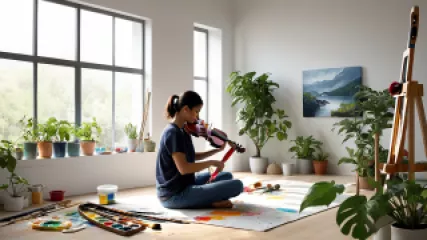Expressive Arts Therapy for Stress Relief: A Step-by-Step Guide
Expressive Arts Therapy for Stress Relief: A Step-by-Step Guide
Navigating the challenges of modern life can be overwhelming at times, leaving many of us feeling stressed, anxious, and in need of effective coping mechanisms. One powerful tool that has gained significant attention in recent years is expressive arts therapy. This unique approach combines various creative modalities, from visual arts and music to movement and storytelling, to help individuals process emotions, reduce stress, and achieve greater mental clarity.
In this comprehensive guide, we will delve into the transformative power of expressive arts therapy and explore a step-by-step process to harness its benefits for stress relief. Whether you're seeking a way to unwind after a demanding workday or looking to cultivate a deeper connection with your inner self, this guide will provide you with the insights and practical steps to embark on a meaningful journey of self-expression and stress management.
Understanding Expressive Arts Therapy
Expressive arts therapy is a holistic approach that integrates various creative modalities to support mental, emotional, and even physical well-being. Unlike traditional talk therapy, which primarily focuses on verbal expression, expressive arts therapy encourages individuals to explore and convey their thoughts, feelings, and experiences through a wide range of creative outlets.
The underlying premise of expressive arts therapy is that the act of creating, whether it's through painting, writing, music, or movement, can serve as a powerful bridge between the conscious and unconscious mind. By tapping into the subconscious and allowing for non-verbal forms of expression, individuals can gain deeper insights into their emotions, uncover hidden patterns, and find new ways to process and manage stress.
One of the key benefits of expressive arts therapy is its ability to bypass the rational, analytical mind and access the intuitive, emotional realm. This can be particularly helpful for individuals who struggle to articulate their feelings through traditional talk-based therapies. By engaging the senses and the creative spirit, expressive arts therapy can provide a safe and transformative space for self-discovery, emotional processing, and stress relief.
The Benefits of Expressive Arts Therapy for Stress Relief
Expressive arts therapy has been widely recognized for its ability to alleviate stress and promote overall well-being. Here are some of the key benefits of this approach:
1. Emotional Expression and Processing
Stress often arises from our inability to process and express difficult emotions. Expressive arts therapy provides a platform for individuals to externalize their feelings, whether it's through painting, writing, or movement. This process of creative self-expression can help release pent-up emotions, foster emotional awareness, and facilitate a greater understanding of one's internal landscape.
2. Stress Reduction and Relaxation
The act of engaging in creative activities can have a calming and grounding effect on the mind and body. The focus and concentration required for creative expression can serve as a natural form of meditation, helping to quiet the mind and reduce physiological symptoms of stress, such as elevated heart rate and muscle tension.
3. Enhanced Self-Awareness and Insight
Expressive arts therapy can provide a window into the subconscious, allowing individuals to uncover deeply held beliefs, patterns, and emotions that may be contributing to their stress. By engaging in creative explorations, individuals can gain valuable insights into the root causes of their stress and develop more effective coping strategies.
4. Improved Mood and Well-Being
Numerous studies have shown that the practice of expressive arts therapy can lead to a significant improvement in mood and overall well-being. The act of creating can trigger the release of feel-good neurotransmitters, such as dopamine and serotonin, which can help alleviate symptoms of depression, anxiety, and stress.
5. Enhanced Resilience and Coping Mechanisms
Engaging in expressive arts therapy can help individuals develop a more robust and diverse set of coping strategies to manage stress. By exploring different creative modalities, individuals can discover new ways to process and express their emotions, ultimately fostering greater resilience and adaptability in the face of life's challenges.
Step-by-Step Guide to Expressive Arts Therapy for Stress Relief
Now that we've explored the foundational understanding of expressive arts therapy and its benefits for stress relief, let's dive into a step-by-step guide to help you incorporate this transformative practice into your life.
Step 1: Assess Your Current Stress Levels
Before embarking on your expressive arts therapy journey, it's important to take a moment to reflect on your current stress levels. Consider the physical, emotional, and mental symptoms you've been experiencing, such as muscle tension, irritability, or difficulty concentrating. This self-assessment will not only help you identify the areas that need the most attention but also serve as a benchmark to measure the impact of your expressive arts therapy practice.
Step 2: Choose Your Creative Modality
One of the unique aspects of expressive arts therapy is the wide range of creative modalities available. From visual arts, such as painting, drawing, and collage, to music, dance, and creative writing, the possibilities are endless. Take some time to explore different creative avenues and identify the ones that resonate most with you. Consider your personal preferences, past experiences, and any existing skills or talents you may have in certain creative areas.
Step 3: Set up Your Creative Space
Creating a dedicated space for your expressive arts therapy practice can greatly enhance your experience and promote a sense of mindfulness and focus. Choose a quiet, well-lit area that is free from distractions and allows you to fully immerse yourself in the creative process. Gather the necessary materials, such as art supplies, musical instruments, or writing tools, and ensure that your space is comfortable and inviting.
Step 4: Engage in Creative Exploration
With your creative space set up and your chosen modality in hand, it's time to begin your expressive arts therapy session. Approach this time with a sense of openness, curiosity, and non-judgment. Allow your intuition to guide you, and don't worry about the final product or outcome. Focus on the process of creating and expressing yourself through the medium you've selected.
If you're engaging in visual arts, such as painting or drawing, consider starting with a simple prompt or theme, such as "exploring your inner landscape" or "visualizing your stress." Allow your emotions and subconscious to guide the brushstrokes or the placement of your pencil on the page. If you're exploring movement or dance, let your body respond to the music or your internal rhythms, and allow the movement to flow freely.
Remember, the goal of this step is not to create a masterpiece, but rather to use the creative process as a means of self-expression and emotional processing. Embrace the journey, and be open to the insights and discoveries that may arise.
Step 5: Reflect and Process
After your creative exploration, take some time to reflect on the experience. Consider the emotions, thoughts, and sensations that arose during the creative process. You may find it helpful to journal, discuss your experience with a trusted friend or therapist, or simply sit in silent contemplation.
This reflective step is crucial for integrating the insights and transformative experiences that may have emerged through your expressive arts therapy session. By taking the time to process and analyze your creative expression, you can gain a deeper understanding of the root causes of your stress and develop more effective coping strategies.
Step 6: Incorporate Expressive Arts Therapy into Your Routine
To truly harness the stress-relieving benefits of expressive arts therapy, it's important to make it a regular part of your self-care routine. Aim to incorporate creative expression into your daily or weekly schedule, even if it's just for a short period of time. Consistency is key, as the sustained practice of expressive arts therapy can lead to lasting improvements in your mental, emotional, and physical well-being.
Remember, the specific creative modality you choose and the frequency of your practice may evolve over time. Be open to exploring different creative avenues and experimenting with various approaches to find what works best for you.
Conclusion
Expressive arts therapy offers a powerful and transformative approach to stress relief, providing individuals with a holistic way to process emotions, foster self-awareness, and cultivate greater well-being. By following the step-by-step guide outlined in this article, you can embark on a journey of creative self-expression and unlock the profound benefits of this unique therapeutic practice.
Remember, the path to stress relief through expressive arts therapy is a personal one. Embrace the process, be patient with yourself, and allow the creative journey to unfold organically. With practice and dedication, you'll discover the profound impact that expressive arts therapy can have on your overall mental, emotional, and physical well-being.
So, take a deep breath, gather your creative supplies, and dive into the transformative world of expressive arts therapy. Let the power of self-expression be your guide to a more balanced, resilient, and stress-free life.






